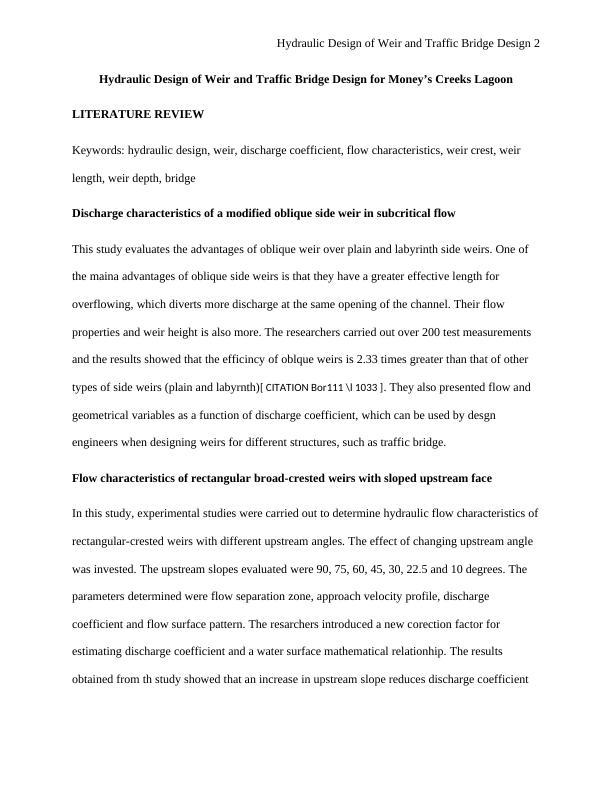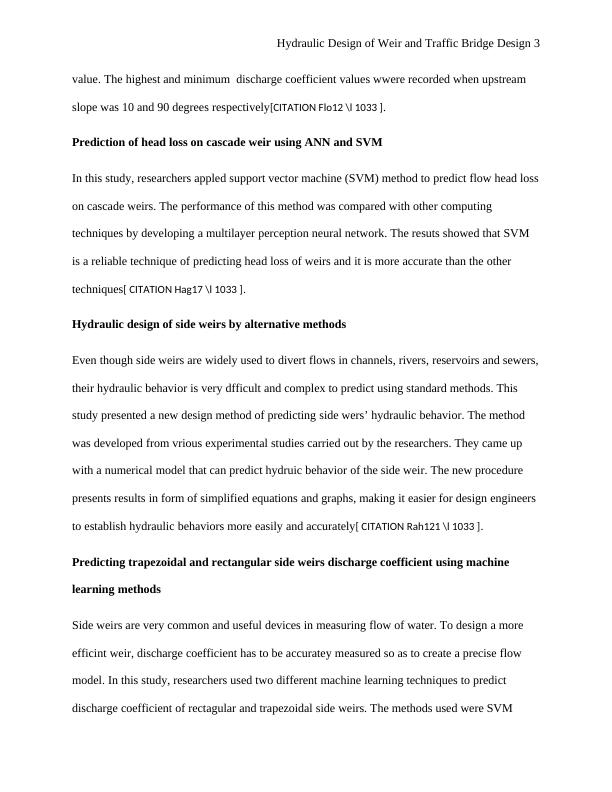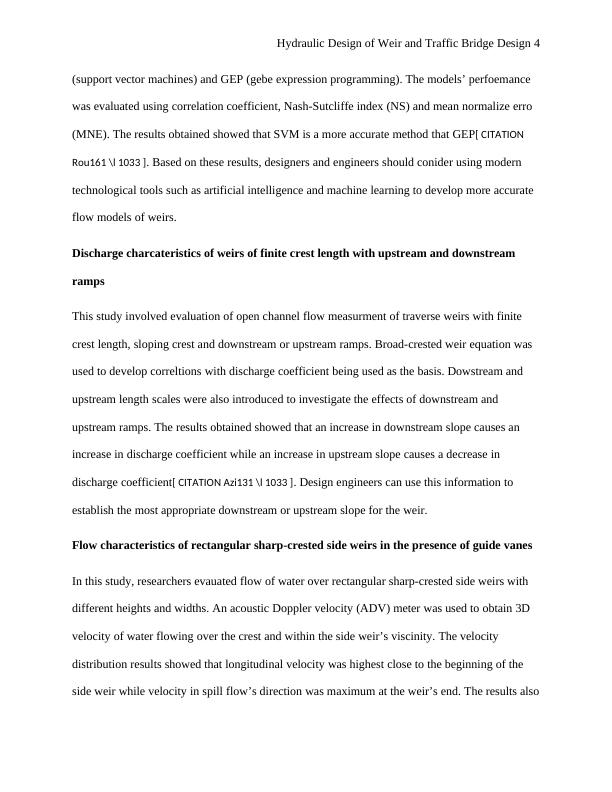Ask a question from expert
Hydraulic behaviour of flow over an oblique weir
12 Pages3475 Words133 Views
Added on 2021-05-31
Hydraulic behaviour of flow over an oblique weir
Added on 2021-05-31
BookmarkShareRelated Documents
Hydraulic Design of Weir and Traffic Bridge Design 1HYDRAULIC DESIGN OF WEIR AND TRAFFIC BRIDGE DESIGN FOR MONEY’SCREEKS LAGOONNameCourseProfessorUniversity City/stateDate

Hydraulic Design of Weir and Traffic Bridge Design 2Hydraulic Design of Weir and Traffic Bridge Design for Money’s Creeks LagoonLITERATURE REVIEWKeywords: hydraulic design, weir, discharge coefficient, flow characteristics, weir crest, weir length, weir depth, bridge Discharge characteristics of a modified oblique side weir in subcritical flowThis study evaluates the advantages of oblique weir over plain and labyrinth side weirs. One of the maina advantages of oblique side weirs is that they have a greater effective length for overflowing, which diverts more discharge at the same opening of the channel. Their flow properties and weir height is also more. The researchers carried out over 200 test measurements and the results showed that the efficincy of oblque weirs is 2.33 times greater than that of other types of side weirs (plain and labyrnth)[ CITATION Bor111 \l 1033 ]. They also presented flow and geometrical variables as a function of discharge coefficient, which can be used by desgn engineers when designing weirs for different structures, such as traffic bridge.Flow characteristics of rectangular broad-crested weirs with sloped upstream faceIn this study, experimental studies were carried out to determine hydraulic flow characteristics ofrectangular-crested weirs with different upstream angles. The effect of changing upstream angle was invested. The upstream slopes evaluated were 90, 75, 60, 45, 30, 22.5 and 10 degrees. The parameters determined were flow separation zone, approach velocity profile, discharge coefficient and flow surface pattern. The resarchers introduced a new corection factor for estimating discharge coefficient and a water surface mathematical relationhip. The results obtained from th study showed that an increase in upstream slope reduces discharge coefficient

Hydraulic Design of Weir and Traffic Bridge Design 3value. The highest and minimum discharge coefficient values wwere recorded when upstream slope was 10 and 90 degrees respectively[CITATION Flo12 \l 1033 ]. Prediction of head loss on cascade weir using ANN and SVMIn this study, researchers appled support vector machine (SVM) method to predict flow head losson cascade weirs. The performance of this method was compared with other computing techniques by developing a multilayer perception neural network. The resuts showed that SVM is a reliable technique of predicting head loss of weirs and it is more accurate than the other techniques[ CITATION Hag17 \l 1033 ].Hydraulic design of side weirs by alternative methodsEven though side weirs are widely used to divert flows in channels, rivers, reservoirs and sewers,their hydraulic behavior is very dfficult and complex to predict using standard methods. This study presented a new design method of predicting side wers’ hydraulic behavior. The method was developed from vrious experimental studies carried out by the researchers. They came up with a numerical model that can predict hydruic behavior of the side weir. The new procedure presents results in form of simplified equations and graphs, making it easier for design engineers to establish hydraulic behaviors more easily and accurately[ CITATION Rah121 \l 1033 ].Predicting trapezoidal and rectangular side weirs discharge coefficient using machine learning methodsSide weirs are very common and useful devices in measuring flow of water. To design a more efficint weir, discharge coefficient has to be accuratey measured so as to create a precise flow model. In this study, researchers used two different machine learning techniques to predict discharge coefficient of rectagular and trapezoidal side weirs. The methods used were SVM

Hydraulic Design of Weir and Traffic Bridge Design 4(support vector machines) and GEP (gebe expression programming). The models’ perfoemance was evaluated using correlation coefficient, Nash-Sutcliffe index (NS) and mean normalize erro (MNE). The results obtained showed that SVM is a more accurate method that GEP[ CITATION Rou161 \l 1033 ]. Based on these results, designers and engineers should conider using modern technological tools such as artificial intelligence and machine learning to develop more accurate flow models of weirs. Discharge charcateristics of weirs of finite crest length with upstream and downstream rampsThis study involved evaluation of open channel flow measurment of traverse weirs with finite crest length, sloping crest and downstream or upstream ramps. Broad-crested weir equation was used to develop correltions with discharge coefficient being used as the basis. Dowstream and upstream length scales were also introduced to investigate the effects of downstream and upstream ramps. The results obtained showed that an increase in downstream slope causes an increase in discharge coefficient while an increase in upstream slope causes a decrease in discharge coefficient[ CITATION Azi131 \l 1033 ]. Design engineers can use this information to establish the most appropriate downstream or upstream slope for the weir. Flow characteristics of rectangular sharp-crested side weirs in the presence of guide vanesIn this study, researchers evauated flow of water over rectangular sharp-crested side weirs with different heights and widths. An acoustic Doppler velocity (ADV) meter was used to obtain 3D velocity of water flowing over the crest and within the side weir’s viscinity. The velocity distribution results showed that longitudinal velocity was highest close to the beginning of the side weir while velocity in spill flow’s direction was maximum at the weir’s end. The results also

End of preview
Want to access all the pages? Upload your documents or become a member.